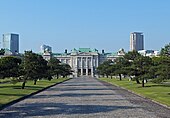Akasaka Palace
| Akasaka Palace | |
|---|---|
| Native name Crown Prince Daijō Tennō | |
National Treasure of Japan | |
| Designated | 2009 |
Akasaka Palace (赤坂離宮, Akasaka Rikyū) is a state guest house (迎賓館, geihinkan) of the government of Japan. Other state guesthouses include the Kyoto State Guest House and the Osaka State Guest House.
The palace was originally built as the Imperial Palace for the Crown Prince (東宮御所, Tōgū Gosho) in 1909. Today the palace is designated by the Government of Japan as an official accommodation for visiting state dignitaries. Located in the
Overview


Location: Tokyo, Minato-ku, Moto-Akasaka-chome No. 1
The building has 15,000 m2 of floor space, and together with a smaller structure in the Japanese style, occupies a 117,000 m2 site.
The main building is a
The palace is surrounded by a footpath unobstructed by road crossings. The footpath is approximately 3.25 km long (roughly 2 miles).
The railway station nearest the Palace is Yotsuya Station.
History
The territory that Akasaka Palace now occupies was part of the residence of Kishū Domain, one of the major branches of the ruling Tokugawa clan, during the Tokugawa period.[2] After the Meiji Restoration, the Owari presented the land to the Imperial Household.
Designed by the architect
After the
Through the economic revival of the country after the Second World War, the Japanese Government established a State Guest House. The former residence of Prince Asaka, currently Tokyo Metropolitan Teien Art Museum, had been used as the state guest house, though it was too small for that purpose. It was decided in 1967 to renovate the former Akasaka Palace as the new state guest house. The renovation was led by architect Togo Murano, took more than five years and 10.8 billion yen, and was completed in 1974.
The first official state guest at the renovated palace was
The venue was closed from 2006 to 2009 for renovation, and was reopened in April 2009. In December 2009, the main building, the main gate and the garden with fountain were designated as a
Gallery
-
main entrance and garden
-
main entrance
-
Main Garden
-
Annex Yushin-tei
-
Safety facilities and national treasure accompanying Akasaka-yuen
-
Gate
-
The Diet Library existed in the palace (1948)
-
Japan's Prime Minister Abe Shinzo meeting U.S. President Donald J. Trump (May 27, 2019)
See also
- Rokumeikan
- Imperial Hotel, Tokyo
- Palace Hotel, Tokyo
- Royal Palace of El Pardo, the state guest house of Spain.
- Blair House, the state guest house of the United States
- Hyderabad House, the state guest house of India
- Diaoyutai State Guesthouse, the state guest house of the People's Republic of China
- Republic of China
References
- ^ a b c 国宝・重要文化財(建造物)の指定について (PDF) (in Japanese). Tokyo: Agency for Cultural Affairs. October 16, 2009. Archived from the original (PDF) on October 8, 2010.
- ^ a b c d Cabinet Office, Government of Japan (2008). 迎賓館 [Reception hall] (in Japanese). Archived from the original on March 10, 2010. Retrieved March 4, 2010.
- ^ a b 昭和聖徳記念財団 (Showa Memorial Foundation). 6月公開「山本内閣親任式の図」 (in Japanese). Retrieved March 4, 2010.
- ^ 国立国会図書館 (National Diet Library). 沿革 [History] (in Japanese). Archived from the original on September 26, 2010. Retrieved March 4, 2010.










